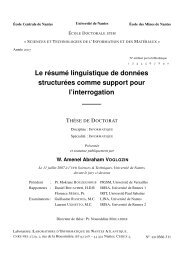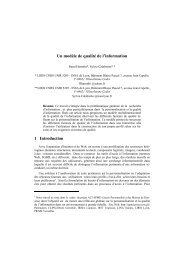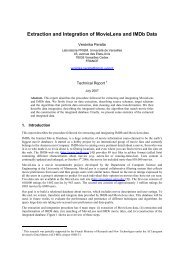64 J Intell Inf Syst (2006) 26: 59–73Table 1 Part <strong>of</strong> theMATERIALS table Materials Tuple TranslationUZ40 t a =〈10, 38, 900〉 t a1 =〈0.7/medium, 1.0/s<strong>of</strong>t,0.85/moderated 〉CuSn12 t b =〈8, 40, 850〉 t b1 =〈0.35/medium, 0.9/s<strong>of</strong>t,1.0/moderated 〉,t b2 =〈0.35/thin, 0.9/s<strong>of</strong>t,1.0/moderated 〉CuAs05 t c =〈12, 44, 896〉 t c1 =〈1.0/medium, 0.4/s<strong>of</strong>t,0.9/moderated 〉,t c2 =〈1.0/medium, 0.4/hard,0.9/moderated 〉Fe t d =〈10, 35, 1530〉 t d1 =〈0.7/medium, 1.0/s<strong>of</strong>t,0.85/normal 〉Ni t e =〈5, 35, 1453〉 t e1 =〈1.0/thin, 1.0/s<strong>of</strong>t,0.96/normal 〉... ... ...Fig. 2 Part <strong>of</strong> a <strong>summary</strong>hierarchy for MATERIALSt e .thickness = 5 mm is expressed as t e1 .thickness ={1.0/thin} where 1.0 tells howwell the label thin describes the value 5mm(1.0 is the satisfaction degree <strong>of</strong> thin by 5mm).Applying this mapping to each attribute <strong>of</strong> a relation corresponds to a translation <strong>of</strong> the initialtuple into another expression called a candidate tuple.One attribute value may be described by more than one fuzzy label (e.g. 8mmis describedby medium and thin). It follows that one tuple (for instance t b and t c in Table 1) may yieldmany candidate tuples.Second, each candidate tuple is incorporated into the growing hierarchy and reaches a leafnode where other candidate tuples with the same labels are stored. This can be seen as a classification<strong>of</strong> the candidate tuple. It is important to notice that the tree is modified throughoutcandidate tuples incorporation: it progressively becomes a complete representation <strong>of</strong> thedata. Its evolution is partly controlled by learning operators (see Raschia, 2001) that try tomaximize the inner-class similarity and the inter-class dissimiliarity.An analogy could be that the hierarchy <strong>of</strong> summaries is a network <strong>of</strong> pipes with a singleentry point at the top and several outlets to a set <strong>of</strong> buckets at the bottom, one outlet perbucket. Candidate tuples can be seen as objects <strong>of</strong> different types. From the entry, an object isdirected to the bucket it belongs to. But through the process <strong>of</strong> reaching the adequate bucket,it creates some structural modifications in the network <strong>of</strong> pipes so some craftsmen (that is, thelearning operators) have to constantly adapt the network. Some junctions are made thinneror larger, some pipes are added or deleted, etc... In the end, all objects <strong>of</strong> the same type aredispatched into buckets and the lengths <strong>of</strong> paths to the buckets are minimal. Each bucket thatSpringer
J Intell Inf Syst (2006) 26: 59–73 65Table 2 Description <strong>of</strong> some summariesSummary Intension Coverz 3 〈 1.0/medium, 1.0/s<strong>of</strong>t, 1.0/moderated 〉 t a1 , t b1 , t c1z 4 〈 0.7/medium, 1.0/s<strong>of</strong>t, 0.85/normal 〉 t d1z 5 〈 0.35/thin, 0.9/s<strong>of</strong>t, 1.0/moderated 〉 t b2z 6 〈 1.0/medium, 0.4/hard, 0.9/moderated 〉 t c2z 7 〈 1.0/thin, 1.0/s<strong>of</strong>t, 0.96/normal 〉 t e1z 1z 2z 0〈 1.0/medium,1.0/s<strong>of</strong>t,1.0/moderated + 0.85/normal 〉 z 3 , z 4〈 1.0/thin + 1.0/medium,1.0/s<strong>of</strong>t + 0.4/hard,1.0/moderated + 0.96/normal 〉 z 5 , z 6 , z 7〈 1.0/thin + 1.0/medium + 0.7/thick,1.0/s<strong>of</strong>t + 0.4/hard,1.0/moderated + 0.96/normal + 0.75/high 〉 z 1 , z 2is not empty at the end after all objects have been through the network <strong>of</strong> pipes is labeledwith a description <strong>of</strong> its contents.From the semantic point <strong>of</strong> view, a <strong>summary</strong> is a concept, a set <strong>of</strong> records which aresimilar when rewritten with the terms from the linguistic variables. If the user had to describethe records in the <strong>database</strong> using the vocabulary they have provided, they would have giventhe same descriptions many times for different records. Instead <strong>of</strong> repeating these instances,a <strong>summary</strong> reflects each description once, keeping track <strong>of</strong> what records share the samedescription.In the hierarchy structure, a level (i.e., a depth in the tree <strong>of</strong> summaries) can be associatedwith the relative proportion <strong>of</strong> data a <strong>summary</strong> describes: the deeper the <strong>summary</strong> in the tree(or the lower its level in the hierarchy), the finer the granularity. It follows that the lowestlevels (the leaves) contain the most precise and specific summaries. Such summaries canbe expressed in the same way as candidate tuples: z =〈α 1 /d 1 ,α 2 /d 2 ,...,α n /d n , 〉. Thisexpression is called the intension or intensional expression <strong>of</strong> the <strong>summary</strong>. It is an importantpoint to note that there is only one label per attribute in the leaf summaries (see z 3 in Table2). Moreover, an initial relational tuple can correspond to several leaves.By contrast, the root <strong>of</strong> the tree is the most general <strong>summary</strong> as it covers all the data. Theintensional expression <strong>of</strong> non-leaf summaries has one or more multi-labeled attributes (e.g.z 1 and z 2 ). This depends on the labels in candidate tuples covered by the summaries. Thus,in these intermediate-level summaries (the non-leaf nodes <strong>of</strong> the hierarchy tree), the labelsare obtained by just the union <strong>of</strong> the labels <strong>of</strong> the children summaries.4. Description <strong>of</strong> the querying processAs stated in Section 2, the first step <strong>of</strong> a <strong>database</strong> flexible querying process consists inextending selection criteria. The linguistic variables used in SAINTETIQ already perform thecriteria extension task prior to the actual summarization process. As a consequence, binaryinclusion operators can be used to identify the summaries (and also, the relational data)Springer







